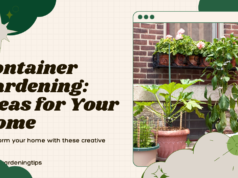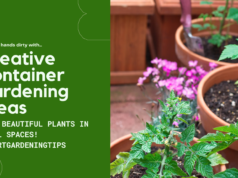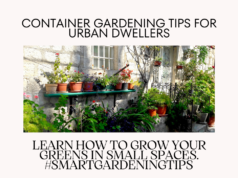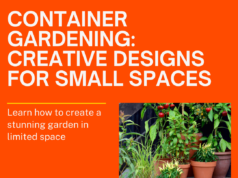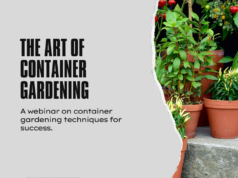Common Container Gardening Challenges
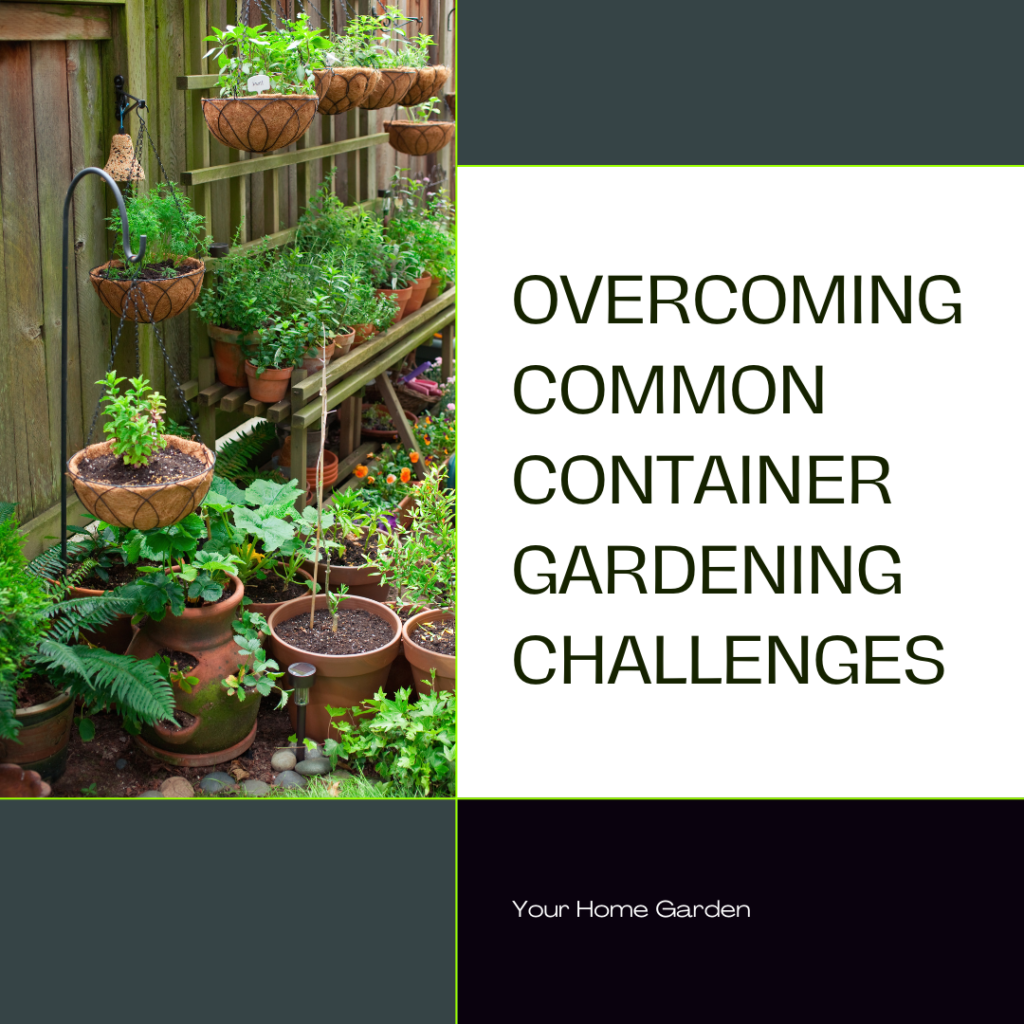
Container gardening is a popular practice that allows you to grow plants in a limited space, whether you have a small balcony or a deck. However, it also comes with its own set of challenges that can make it difficult for your plants to thrive. In this section, we will explore the most common container gardening challenges and provide tips on how to overcome them.
Key Takeaways:
- Container gardening comes with its own set of challenges.
- Limited space for root growth is one of the primary disadvantages of container gardening.
- Watering and drainage issues can also pose a problem for container gardeners.
- Nutrient depletion in container soils can lead to plant health issues.
- Pests and diseases can easily spread in the confined space of a container garden.
Here are the Common Container Gardening Challenges.
Limited Space for Root Growth
When it comes to container gardening, one of the major limitations you’ll face is the limited space available for root growth. Unlike plants grown in the ground, container plants have restricted room to spread their roots. This can affect their overall growth and productivity.
However, there are ways to tackle this disadvantage and promote healthy root development. One solution is to choose containers that are large enough to accommodate your plants’ roots. A general rule of thumb is to opt for containers that are at least 12 inches deep and wide, to allow enough space for the roots to grow.
| Container Size | Suitable Plants |
|---|---|
| 12 to 14 inches | Lettuce, spinach, radish, green onions, herbs |
| 16 to 20 inches | Bush beans, beets, carrots, chard, kale, peppers, small tomatoes |
| 24 inches or larger | Eggplant, large tomatoes, squash, cucumbers, melons, root vegetables |
You should also consider the depth requirements of different plant varieties. For instance, plants with shallow roots, such as lettuce and spinach, can thrive in shallower containers. In contrast, deep-rooted plants like tomatoes and cucumbers require deeper containers.
Another solution is to use specialized containers designed to provide more root space. These include rectangular window boxes, half barrels, and fabric pots. Fabric pots, in particular, are lightweight and allow for better aeration and drainage.
Finally, you can create a vertical garden using planters that are stacked on top of each other. This makes use of vertical space and allows for more plants in the same area.
With these solutions, you can overcome the limitation of limited root space and ensure that your container plants have ample space to grow and thrive in.
Checkout our article on what plants are good for container gardening .
Watering and Drainage Issues
A pair of hands gently pouring water into a container garden. Droplets of water glistening on the leaves and soil below. The sunlight shining overhead, casting shadows on the surrounding area. The container garden sitting on a wooden deck or concrete patio. A watering can or hose nearby, ready for refilling. A few flowers or herbs peeking out from between the plants, adding a pop of color to the scene.
Successful container gardening requires attention to proper watering and drainage. However, these factors can be challenging to manage. Overwatering can lead to root rot and other plant health issues, while underwatering can cause plants to dry out and wither. Additionally, poor drainage can lead to waterlogged soil and root suffocation.
Some of the difficulties of container gardening related to watering and drainage include:
- Determining the optimal watering frequency for your plants
- Ensuring proper drainage to prevent water buildup
- Choosing the right soil mix to promote drainage and moisture retention
To address these issues, you can:
- Monitor soil moisture levels regularly to avoid over or under watering.
- Use containers with adequate drainage holes or add extra holes if necessary.
- Choose a high-quality soilless mix that contains perlite or vermiculite to promote drainage and moisture retention.
It’s also important to water your plants properly. Instead of simply pouring water over the top of the soil, water slowly and deeply, allowing the water to permeate the entire root zone. You can also use a watering can or drip irrigation system to regulate the amount of water your plants receive.
Finally, consider using a saucer to collect excess water and prevent it from sitting in the container. However, make sure to empty the saucer regularly to avoid water buildup.
Tip: One way to determine when your plants need water is to stick your finger into the soil. If the top inch of soil feels dry, it’s time to water.
Nutrient Depletion in Containers
Container gardens have limited space, meaning that the soil in which plants grow quickly becomes depleted of nutrients. This can lead to nutrient deficiencies in your plants and negatively impact their growth and productivity.
In garden soil, the larger volume helps distribute nutrients more effectively, reducing the likelihood of nutrient deficiencies. Additionally, when you water plants in the ground, the soil holds moisture, providing a constant supply of water and nutrients.
However, with container gardens, frequent watering can lead to water leaching through the soil and taking nutrients with it. Over time, this can lead to a lack of essential nutrients, such as nitrogen, potassium, and phosphorus.
There are several ways to address nutrient depletion in container gardens to ensure that your plants receive the nutrients they need to thrive.
Fertilization
Fertilizing your container garden regularly is crucial to replenishing soil nutrients and preventing nutrient deficiencies. Choose a high-quality, balanced fertilizer that includes essential nutrients such as nitrogen, potassium, and phosphorus.
| Pros of Fertilizing | Cons of Fertilizing |
|---|---|
| Replenishes soil nutrientsPromotes healthy plant growthEasy to apply | Over-fertilization can harm plantsSome fertilizers can be expensiveChemical fertilizers can be harmful to the environment |
Apply fertilizer according to the manufacturer’s instructions, taking care not to over-fertilize, as this can harm your plants.
Crop Rotation
Crop rotation is another effective way to prevent nutrient depletion in container gardens. Instead of planting the same crop in the same container year after year, rotate your plants with different crops. This helps to ensure that the soil is not depleted of specific nutrients that a particular crop requires.
“Crop rotation is a simple, yet effective method for preventing nutrient depletion and promoting soil health in container gardens.”
Composting
Composting is an eco-friendly way to add nutrients to your container soil without using chemical fertilizers. By adding compost to your soil, you can increase its fertility and help prevent nutrient depletion.
In conclusion, nutrient depletion is a common problem faced by container gardeners due to the limited space and frequent watering requirements. To prevent nutrient deficiencies and promote healthy plant growth, consider fertilizing regularly, crop rotation, and composting. By implementing these strategies, you can ensure that your container garden stays healthy and productive.
Pests and Diseases in Containers
Although container gardens have many advantages, they are not invincible to pests and diseases. The limited space and potential lack of natural predators can make containers more susceptible to infestations.
Common pests in container gardens include aphids, spider mites, whiteflies, and thrips. These pests can cause damage to your plants, such as yellowing leaves or stunted growth.
Diseases can also be a problem in container gardening. Fungal diseases such as powdery mildew, botrytis, and root rot can spread quickly in the confined space of a container.
To manage and prevent pest and disease issues in your container garden, consider the following tips:
- Inspect your plants regularly for signs of pests or diseases. Early detection can help prevent the spread of the problem.
- Remove infected plants or plant parts immediately to prevent the spread of the issue.
- Practice good sanitation by cleaning your tools and containers between planting to prevent the transfer of diseases.
- Consider using natural remedies or organic solutions to treat pests and diseases, such as neem oil or insecticidal soap.
- Companion planting can also help deter pests and improve plant health. For example, planting marigolds or basil alongside tomatoes can help repel pests.
By taking proactive measures to manage and prevent pest and disease issues in your container garden, you can ensure your plants stay healthy and thrive.
Temperature and Climate Challenges
Illustrate a container garden struggling to survive in extreme temperatures. Show wilted and brown leaves on plants, while others may be completely dead or withered. The soil should be dry and cracked, and the background could include a scorching sun or other heat-related elements, such as desert scenery or a heatwave symbolized by waves of heat radiating from the ground. Use muted colors and shadows to convey a feeling of desperation and struggle.
Container gardening comes with certain limitations, and one of the biggest challenges gardeners face is managing temperature and climate variations. Because container plants are grown above ground, they can be more susceptible to extreme weather conditions than plants grown directly in the ground.
One of the drawbacks of container gardening is the lack of insulation available to container plants. Unlike garden soil, which can help regulate temperature fluctuations, container soil is more exposed to the elements. This can be especially problematic in extreme temperatures, as container plants can quickly become damaged or even die in excessively hot or cold weather.
Another factor to consider is the effect of wind and sun exposure on container plants. Strong winds can dry out plants and damage delicate foliage, while intense sun exposure can scorch leaves and cause heat stress.
One solution to combat these challenges is to choose the right location for your container garden. Select a spot that provides adequate shade and shelter from excessive wind. You can also consider using plant covers or shades during extreme weather conditions to protect your plants.
Another strategy is to choose plants that are well-suited to your local climate. Select varieties that can tolerate both hot and cold conditions, and be sure to monitor your container plants regularly for signs of stress or damage.
Choosing the Right Containers
One of the most critical decisions you will make for your container garden is selecting the right containers. The wrong choice can lead to issues in container gardening and the pitfalls of container gardening. Here are some factors to consider when choosing containers:
Size
The size of the container is an essential consideration when selecting one. Downsides of container gardening include limited space, and choosing a container that is too small can hinder the growth of your plants. On the other hand, choosing a container that is too large can lead to overwatering and drainage issues. Consider the size of the plant and its root system and choose a container slightly larger than the root ball.
Material
The material of the container can also affect the growing conditions of your plants. Clay pots are porous and can dry out quickly, making them excellent for plants that require less moisture. Plastic pots, on the other hand, retain moisture better and are perfect for plants that require frequent watering. Other materials, such as metal and wood, require careful consideration of drainage and moisture levels.
Drainage Capability
Drainage is critical for the success of container gardening. If a container does not have adequate drainage, your plants may become waterlogged and develop root rot. Look for containers with drainage holes or make sure to drill them yourself.
By taking the time to choose the right containers, you can avoid container gardening difficulties and set your container garden up for success. Remember to consider the size, material, and drainage capabilities of your containers, and your plants will thrive.
Plant Selection and Combination
Choosing the right plants for your container garden is key, but with so many options available, it can be overwhelming. To make matters more challenging, selecting plants that will thrive together in a container is an added obstacle. In this section, we will discuss some common challenges related to plant selection and combination and offer some tips to make the process easier.
Consider the Growing Conditions
Before you select any plants, take the time to consider the growing conditions of your container garden. Factors such as sunlight, temperature, and humidity can affect the growth and health of your plants. Make sure you choose plants that are compatible with each other and can tolerate the same growing conditions. For example, if you have a sunny container, make sure you select plants that require full sun.
Think About Size and Growth Habits
Another consideration when selecting plants is their size and growth habits. Choose plants that will not outgrow your container or crowd out other plants. Consider the overall shape and form of each plant and how it will contribute to the overall look of your container garden. You can also mix plants with different growth habits to provide more visual interest and texture.
Avoid Overcrowding
It can be tempting to fill your container garden with as many plants as possible, but overcrowded plants can result in poor growth and even disease. Make sure you leave enough space between each plant to allow for proper air circulation and root growth. As a general rule, a 12-inch container can hold up to three small plants or one large plant.
Experiment with Different Combinations
Don’t be afraid to experiment with different plant combinations in your container garden. Mixing plants with different colors, textures, and growth habits can create a beautiful and unique display. You can also try different combinations throughout the year to keep your container garden looking fresh and vibrant.
“Remember, the right plant combination can make all the difference. With some careful planning and experimentation, you can create a container garden that is both beautiful and thriving.”
FAQ
What are some common challenges of container gardening?
How can I overcome limited space for root growth in container gardening?
What can I do to address watering and drainage issues in container gardening?
How can I prevent nutrient depletion in container gardens?
How can I manage pests and diseases in container gardens?
How can I protect my container plants from temperature and climate challenges?
What factors should I consider when choosing containers for my plants?
How can I select and combine plants effectively in container gardening?
Conclusion
While container gardening offers numerous advantages, it also has its own set of challenges that can be discouraging for beginners. However, these drawbacks should not deter you from creating a container garden. By understanding and addressing the common issues discussed in this article, you can ensure that your plants thrive and flourish.
Choose the Right Containers
One of the keys to a successful container garden is choosing the right containers. Factors such as size, material, and drainage capability should be taken into account to ensure optimal growing conditions for your plants.
Provide Adequate Watering and Drainage
Proper watering and drainage are crucial for the health of your container garden. Maintaining the right moisture levels can be a challenge, but with the right techniques, you can ensure that your plants get the water they need without the risk of overwatering.
Address Nutrient Depletion
Nutrient depletion is a common problem in container gardens due to frequent watering and limited space. However, this can be addressed by using high-quality soil and fertilizing your plants on a regular basis.
Manage Pests and Diseases Effectively
Container plants are not immune to pests and diseases. Be vigilant and take the necessary steps to manage and prevent infestations. This includes proper sanitation and the use of natural pest control options whenever possible.
Choose Compatible Plants
Picking the right plants and combining them effectively is crucial for the success of your container garden. By choosing compatible plants that thrive together in containers, you can create a beautiful and productive garden.
Overall, while there are certainly some disadvantages of container gardening, the benefits far outweigh the downsides. By following these tips and strategies, you can create a thriving container garden that brings joy and beauty to your home.


